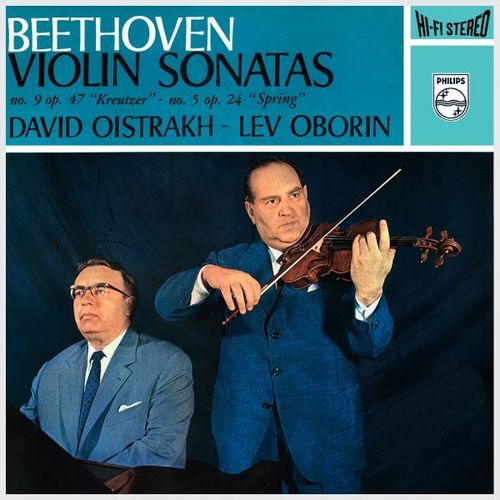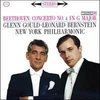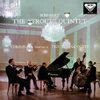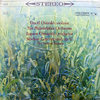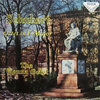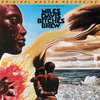Speakers Corner / Philips - 835 259 LY - 180 Gram Virgin Vinyl
AAA 100% Analogue - Limited Edition - 0835 259 Philips
Pure Analogue Audiophile Mastering - Pressed at Pallas Germany
The Absolute Sound Super Disc List TAS Harry Pearson Super LP List
Do Not fail to get this extraordinary LP - Listener Review
Beethoven: Sonatas for Piano and Violin Nos. 5 & 9 – Lew Oborin and David Oistrach
At first sight Beethoven’s Violin Sonatas appear to occupy only a subordinate role when placed alongside his great symphonic works and the piano sonatas. While the earlier works in the genre were viewed in their time with scepticism due to the “rare difficulty” and “learnedness” of their piano part, the later sonatas however display an increasingly marked independence of the violin part. For this reason, the A major Violin Sonata (which was dedicated to the French violinist Rodolph Kreutzer), and the so-called Spring Sonata (whose nickname was added by an unknown hand) soon became two of the most famous representatives of their genre.
David Oistrakh, the brilliant violinist in this Philips re-release, certainly needs no further introduction. All the more attention, therefore, should be given to the great achievement of the less well-known pianist, Lev Oborin, a frequent chamber-music partner of Oistrakh’s. Every possible facet of the instrumental dialogue is captured in Oborin’s performance. He is restrained in passages where the melody is given over to the violin; he and his partner toss the motifs back and forth between them; and he takes the reins firmly into his hands when the music demands it. All this takes place with the precision of a Swiss clock but by no means with mere mechanical virtuosity.
Oistrakh was one of the greatest violinists of his day, and was the most characteristic representative of the Russian school, although his training took place in Odessa. He developed his monumental style during his time in Moscow. He combined supreme technical mastery and musicianship, delivered with a warm and powerful tone. He was very happy to perform new works, and many Soviet composers dedicated works to him (Prokofiev, Shostakovich, Myaskovsky, Khachaturian, Rakov, Vainberg).
He also played sonatas with Lev Oborin and trios with Oborin and Knushevitsky, and was also a talented conductor. He was a teacher at the Moscow Conservatory from 1934, and among his students were his son Igor, Valery Klimov and Gidon Kremer. He was named People's Artist of the USSR in 1954 and was awarded the Lenin Prize in 1960. He was also awarded honours by the Royal Academy of Music in London and the Conservatorio di Saint Cecilia in Rome. His hobby was chess and he played a famous match against Prokofiev in 1937.
Are your records completely analogue?
Yes! This we guarantee!
As a matter of principle, only analogue masters are used, and the necessary cutting delay is also analogue. All our cutting engineers use only Neumann cutting consoles, and these too are analogue. The only exception is where a recording has been made – either partly or entirely – using digital technology, but we do not have such items in our catalogue at the present time
Are your records cut from the original masters?
In our re-releases it is our aim to faithfully reproduce the original intentions of the musicians and recording engineers which, however, could not be realised at the time due to technical limitations. Faithfulness to the original is our top priority, not the interpretation of the original: there is no such thing as a “Speakers Corner Sound”. Naturally, the best results are obtained when the original master is used. Therefore we always try to locate these and use them for cutting. Should this not be possible, – because the original tape is defective or has disappeared, for example – we do accept a first-generation copy. But this remains an absolute exception for us.
Who cuts the records?
In order to obtain the most faithful reproduction of the original, we have the lacquers cut on the spot, by engineers who, on the whole, have been dealing with such tapes for many years. Some are even cut by the very same engineer who cut the original lacquers of the first release. Over the years the following engineers have been and still are working for us: Tony Hawkins, Willem Makkee, Kevin Gray, Maarten de Boer, Scott Hull, and Ray Staff, to name but a few.
At the beginning of the ‘90s, in the early days of audiophile vinyl re-releases, the reissue policy was fairly straightforward. Companies such as DCC Compact Classics, Mobile Fidelity, Classic Records and others, including of course Speakers Corner, all maintained a mutual, unwritten code of ethics: we would manufacture records sourced only from analogue tapes.
Vinyl’s newfound popularity has led many other companies to jump on the bandwagon in the hope of securing a corner of the market. Very often they are not so ethical and use every imaginable source from which to master: CDs, LPs, digital files and even MP3s.
Even some who do use an analogue tape source employ a digital delay line, a misguided ’80s and ‘90s digital technology that replaces the analogue preview head originally used to “tell” the cutter head in advance what was about to happen musically, so it could adjust the groove “pitch” (the distance between the grooves) to make room for wide dynamic swings and large low frequency excursions. Over time analogue preview heads became more rare and thus expensive.
So while the low bit rate (less resolution than a 16 bit CD) digital delay line is less expensive and easier to use than an analogue “preview head”, its use, ironically, results in lacquers cut from the low bit rate digital signal instead of from the analogue source!
Speakers Corner wishes to make clear that it produces lacquers using only original master tapes and an entirely analogue cutting system. New metal stampers used to press records are produced from that lacquer. The only exceptions are when existing metal parts are superior to new ones that might be cut, which includes our release of “Elvis is Back”, which was cut by Stan Ricker or several titles from our Philips Classics series, where were cut in the 1990s using original master tapes by Willem Makkee at the Emil Berliner Studios. In those cases we used only the original “mother” to produce new stampers.
In addition, we admit to having one digital recording in our catalogue: Alan Parsons’ “Eye in the Sky”, which was recorded digitally but mixed to analogue tape that we used to cut lacquers.
In closing, we want to insure our loyal customers that, with but a few exceptions as noted, our releases are “AAA”— analogue tape, an all analogue cutting system, and newly cut lacquers.
